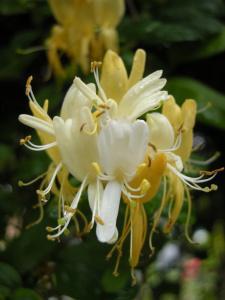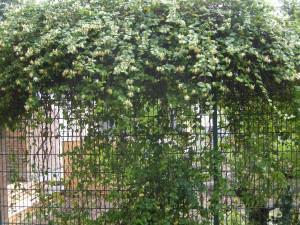
Lonicera periclymenum flower (11/06/2011, London)
Position: Flourishes in full sun to partial shade.
Soil: Moist and well drained.
Flowering period: Summer.
Eventual Height: 7m
Eventual Spread: indefinite
Hardiness: USDA Zones 5a-9b
Family: Caprifoliaceae
Lonicera periclymenum is a deciduous climber with a twining habit. This woody-stemmed fully hardy climber bears oval to oblong, mid green leaves that are grey-green underneath. Its inflorescence is fragrant, especially at night and takes the form of long, tubular cream flowers, which are occasionally tinged pink. These are followed by red mildly poisons berries.
L. periclymenum is commonly known as the common Honeysuckle and derives that name from how traditionally children sucked the sweet nectar from the base of the flower. It is native to most of Europe, including the UK. It is also known as Woodbine due to how it may cause this disease when trained on trees.
Lonicera was named after Adam Lonitzer, a 16th century German botanist and author, with periclymenum being derived from the Greek periklymenon, who was an Argonaut in Greek mythology who had the ability to change his shape; this is in reference to how the Honeysuckle flower changes shape and colour.

Lonicera periclymenum (11/06/2011, London)
The Landscape architect may find this plant useful as a fast growing fragrant native climber which is of great benefit to our native fauna. It can also form an important component of native hedge or woodland planting.
The Royal Horticultural Society have given the cultivars Lonicera periclymenum ‘Graham Thomas’ and ‘Serotina’ their prestigious Award of Garden Merit.
Ecologically this plant will attract pollinating insects such as butterflies and honey bees and the larvae or some species of Lepidoptera will feed on its leaves.
This plant will tolerate almost any soil conditions; it will be happy in acid, neutral or alkaline pH levels, in Chalk, Clay, Sand or Loam based soils in a sheltered or exposed location facing any aspect.
Maintenance: Requires little to no maintenance. May be trimmed in late winter or spring to control excessive growth

